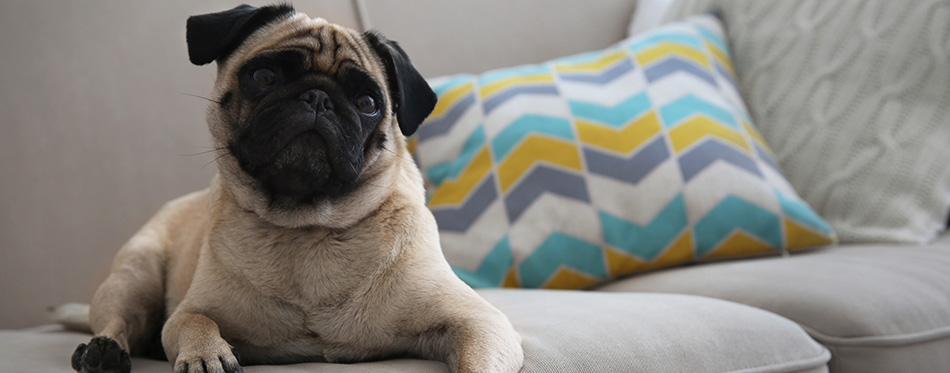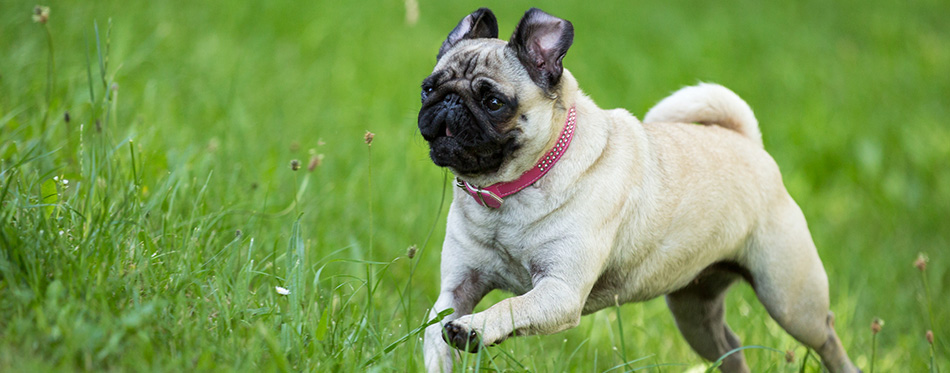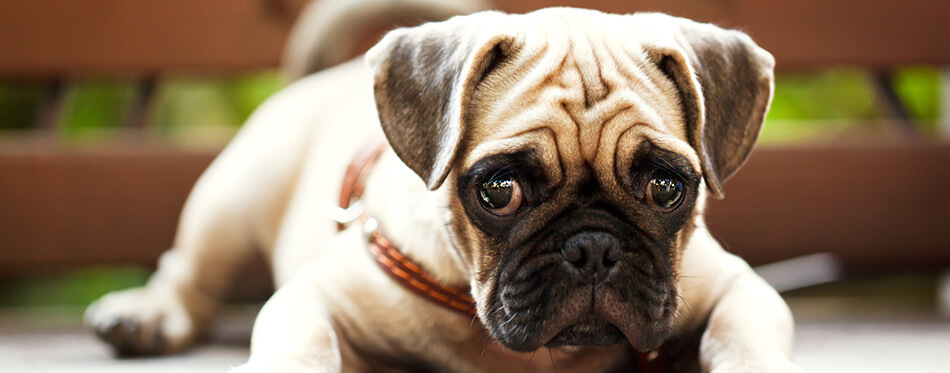With those super-cute bug eyes and compact, soft-furred body, the Pug dog is renowned as the clown of the canine world, making them entertaining, loveable pets that are also easy to care for. Ideal for families, the Pug personality is huge, despite their small size and your get a lot of dog for your money. Although known for their stubborn and at times sensitive side, Pugs are playful and adaptable, at ease in a large family home as they are in an urban apartment.
If you are considering adding a Pug to your family set up, then read on as we give the lowdown on this totally lovable, grumpy-faced clown.

History of the Pug
So, where do Pugs come from? Considered a toy breed by the American Kennel Club, the Pug breed originated in China, and dates back over 2,000 years to the Han dynasty where they were prized companion pets of the Emperors. Ancient Pugs were one of three short-snouted breeds bred by the Chinese, the others were the Lion Dog and the Pekingese. By the late 1500s, China had started trading with Europe and the first Pugs were thought to have been brought back to Holland by traders of the Dutch East India Company. The wrinkled faced pooches really captured the Europeans’ attention and their popularity as a pet grew, especially amongst Royalty and the upper classes. In 1572, a Pug saved the Dutch Prince William from approaching Spanish soldiers by raising the alarm, and as a result the Pug became the official breed for the Royal House of Orange. When William of Orange (William III) took up the English throne, he took his Pugs with him, spreading their popularity even wider.
The breed was standardized in the early 1800s and was first exhibited as a breed in 1861. Queen Victoria became a huge fan of the Pug, maintaining her own pack as well as breeding them. The popularity of the Pug in the Victorian era was huge, and the wide-eyed, short-snouted pooch was often featured in paintings and figurines.
The diminutive Pug with its huge personality finally made its way over the Atlantic to the US just after the Civil War and was recognized as an official breed by the American Kennel Club in 1885. The US embraced the Pug and it quickly became a desirable pet. Today, the breed still ranks within the US’s top 30 most popular dogs to own.
Quick Facts About the Pug
Full of personality, there is never a dull moment when a Pug is around, making this breed a fun, affectionate and typically easy to care for pet. Here are just a few ‘did you know…?’ snippets about the crinkle-faced Pug:
- The name Pug comes from the Latin word, ‘pugnus’ meaning fist, perhaps used to describe the distinctive round head and face of the breed. But the name certainly doesn’t fit with the Pug’s temperament as they are companion rather than guard dogs.
- Pugs are considered the clowns of the dog world and they love to be center of attention, which can cause a few behavioral problems if not correctly managed or worse still, ignored!
- It is believed that the Chinese originally bred the Pug to have deep wrinkles on their face and body as they were considered to resemble good luck symbols.
- Despite being a toy breed, Pugs are not known for being barkers so are ideally suited to apartment living.
- With their flat nose and face, the Pug’s brachycephalic features mean they can have breathing problems (they snore a lot!) and so are not suited to very hot or very cold climates.
- There are three types of Pugs – fawn, black or brindle – and all have a short coat that is double layered which he will shed all-year round so you will need to keep a good vacuum cleaner handy!
- When it comes to how big Pugs get, they are all on the small side, with the maximum height of an adult male around 36cm when fully grown.

Things You Should Know
Comedic, loving, loyal and pretty low maintenance, the Pug is a wonderful companion that will thrive on love. But they do have a stubborn streak and due to their intelligence can be willful and demanding at times. But with early training and sufficient attention, you will find yourself an awesome mini best friend. With typical Pug puppies coming with a $1000+ price tag, they are not cheap. So, to help you decide whether this cute mini-dog is for you and your family, we’ve put together all the essential info you need to know.
Health
The Pug is a robust little fellow and has an average life span of between 13 and 15 years. But with his distinct flat face and bulging eyes, he can be prone to several health conditions:
- Eye Problems – due to the prominence of their eyes, Pugs are vulnerable to eye injuries and disorders, including corneal ulcers, dry eye, abnormal eyelash growth and progressive retinal atrophy. Eye infections are also a common problem for Pugs.
- Skin conditions – the soft folds of his loose skin can leave your Pug vulnerable to skin irritation. Conditions that can affect a Pug include mites and mange as well skin infections such as staph and yeast.
- Brachycephalic Syndrome – this is common in Pugs due to their short head and snout. Also known as brachycephalic airway obstruction syndrome (BAOS), the main symptom is difficulty breathing due to an elongated soft palate and/or narrowed nostrils. Surgery can help to cure this problem.
- Mitral Valve Disease – this heart condition is prevalent in smaller dogs such as Pugs but can be treated. Symptoms to look out for include coughing and lethargy.
- Hip Dysplasia – many small and large breeds are affected by this painful hip condition and Pugs are no exception. Genetics, environment and diet can also contribute to the condition and can lead to a deformity of the hip joint. Thankfully, there are lots of treatment options available for your precious Pug.
- Hemi-vertebrae – misshaped vertebrae in the spine can affect short-nosed dog breeds but depending on the severity most can go on to live full and active lives. More serious cases can lead to lack of coordination and potential paralysis, although surgery can help.
Training
With their strong-willed personalities, it is essential that the Pug is socialized from an early age and you make the most of puppy training to keep his more exuberant tendencies in check. Their stubbornness can also make potty training a little challenging and many experts recommend crate training to help keep things less of a chore.
Pugs are typically mischievous and so their energies need to be channeled into positive pursuits that make having him in your home a total joy. They are intelligent too, so as their pet parent, you need to set boundaries and let him know who is in charge.
Exercise
It’s fair to say that the Pug is no canine athlete, but they do have decent energy levels and their intelligence and curiosity makes them easy candidates to take out for play. However, the breed is just as happy as a lapdog and so can tend to follow a more sedentary life. The key to exercising a Pug is to combine short walks with plenty of playtime, either in the backyard or in the home. Just be mindful of doing too much on hot or cold days as the breed is sensitive to temperature and humidity.
Nutrition
Despite their smaller size, Pugs are food monsters and will overeat if allowed to. They also put on the pounds very easily so obesity can be a real issue if their mealtimes and treats aren’t kept in check.
The secret to keeping a Pug satisfied and healthy is to feed him a high quality, breed appropriate dog food, with proportions that are right for their age and size. Twice daily meals are recommended and keep treats and titbits to an absolute minimum. And as a Pug parent, you also need to be disciplined and avoid feeding him any of your own food, even if those pleading Pug bugeyes are telling you otherwise!
For more guides on choosing the right dog food, you may wish to check out our reviews of the best dry dog food, organic dog food, grain free dog food, wet dog food and dog food for pugs.
Grooming
Don’t let their lovely short coat fool you, Pugs are prolific fur shedders, especially in the summer so a regular brushing routine is essential. Aim for daily brushing if you can, supplemented with a monthly bath to help keep his coat in tip-top condition and shedding to a minimum.
Pug eyes do need regular cleaning and care to prevent any infections, so be gentle when bathing and keep any harsh soaps away from his face; instead wipe his eyes gently with cotton pads, soaked in warm water.
When grooming or bathing, also make sure you pay special attention to the folds in their skin, particularly around the face as these crinkles are hotbeds for dirt and bacteria if not kept clean. And always make sure his fur and skin are thoroughly dried after bathing to avoid any unnecessary skin irritation.
For more help on dog grooming, you may wish to read our guides on the best dog nail grinders, dog dryers, dog clippers, dog wipes and dematting tools for dogs.

Temperament
And finally, understanding the Pug’s unique personality is going to make your relationship with this lovable goofball a real pleasure. Pugs love to be loved and can crave it if not given freely or regularly as they will want to be your constant companion.
They can also be strong-willed so ensure your new Pug has been socialized from an early age and knows who is boss. And don’t forget to shower your Pug with plenty of praise for his good behavior. Pugs are also super-safe to have around children as they really love kids and as he’s not a delicate toy breed but more of a chunky monkey he is robust enough for all that attention. However, he is not going to be a full-on active ball catcher or be able to keep up on long walks or days out hiking.
In short, the Pug temperament means he is a super sociable fellow, confident in his own (wrinkly skin) and loves to have human company. They are adaptable, playful and intelligent, love nothing more than curling up on the sofa with his pet parent and will always be an entertaining companion to have at your side.

